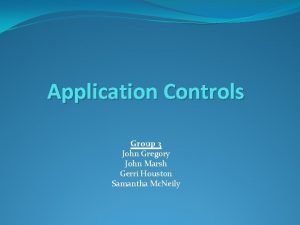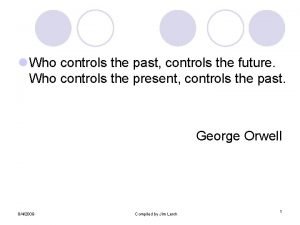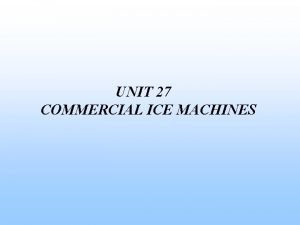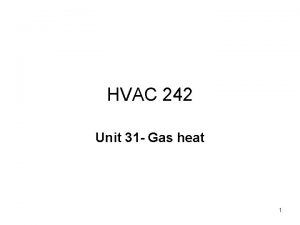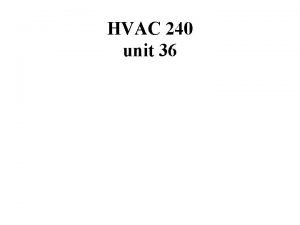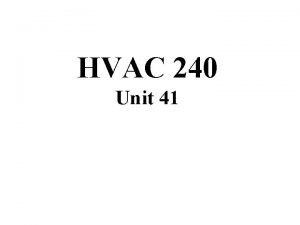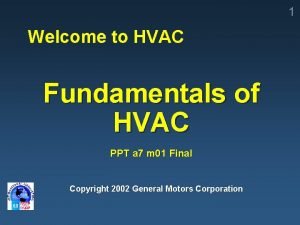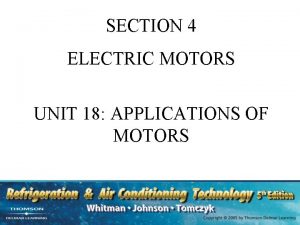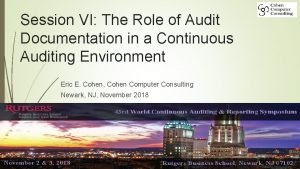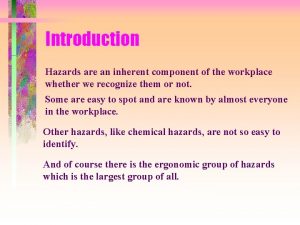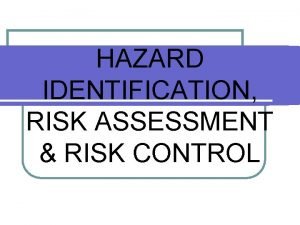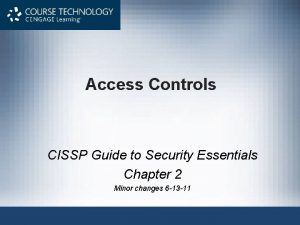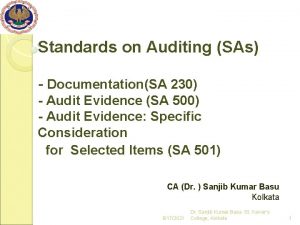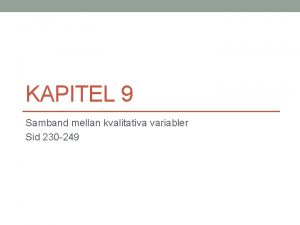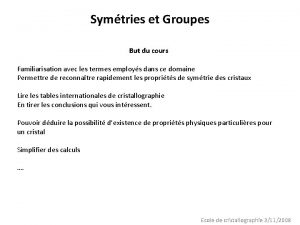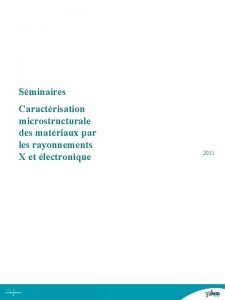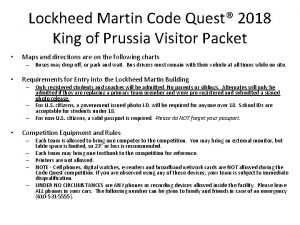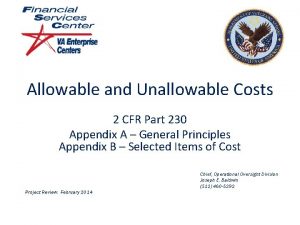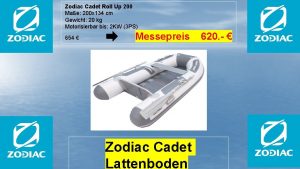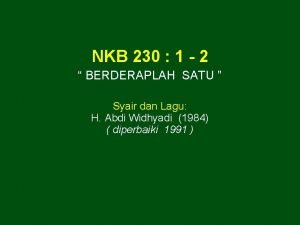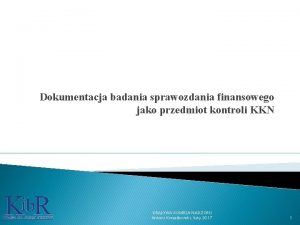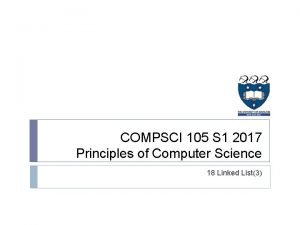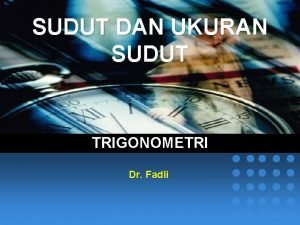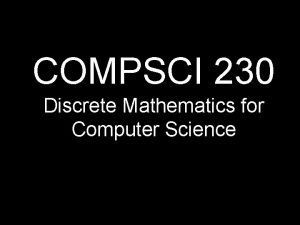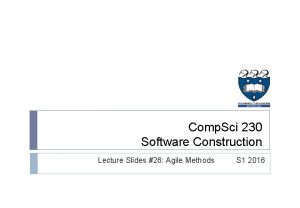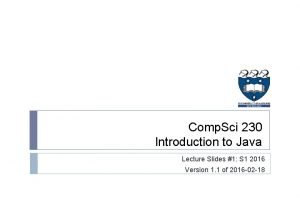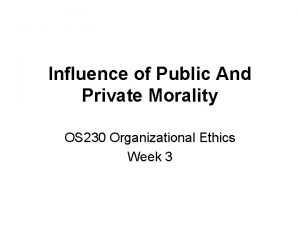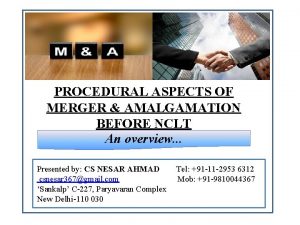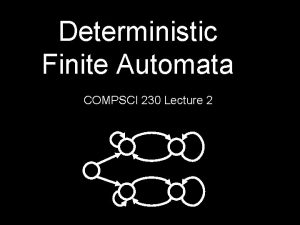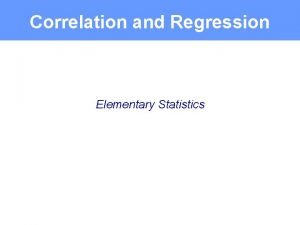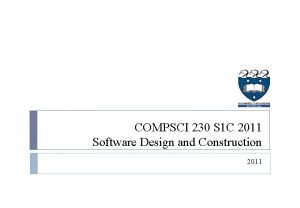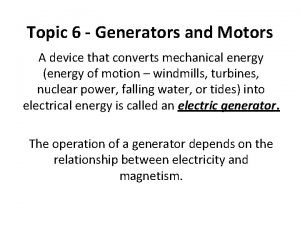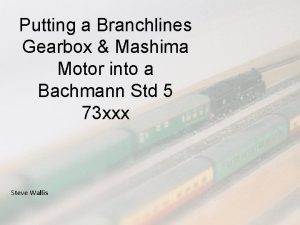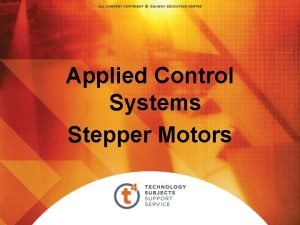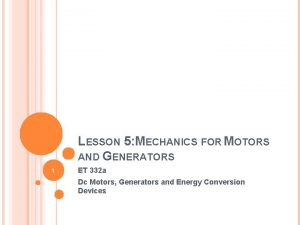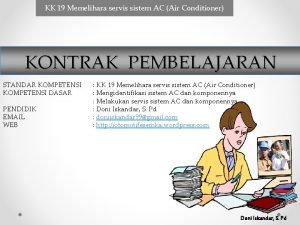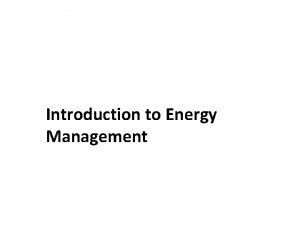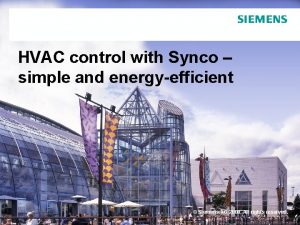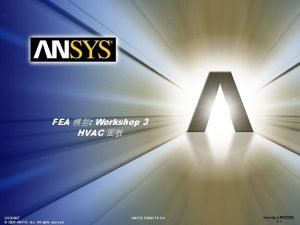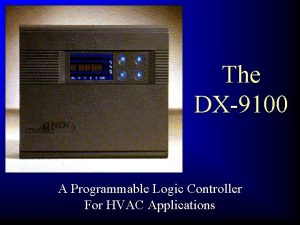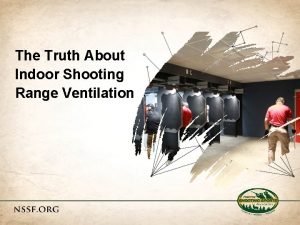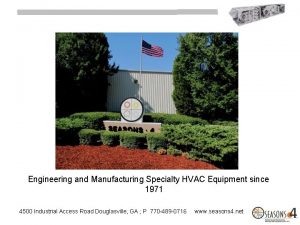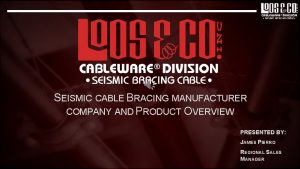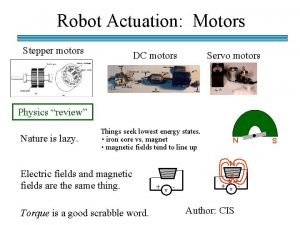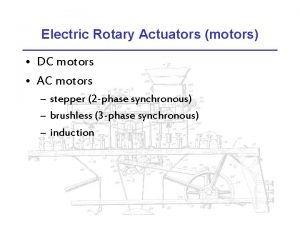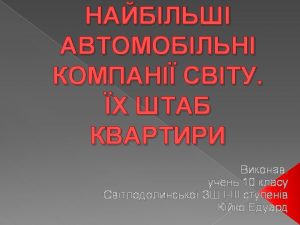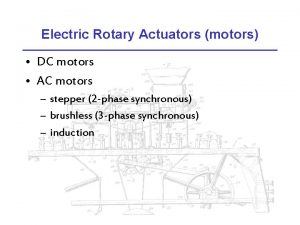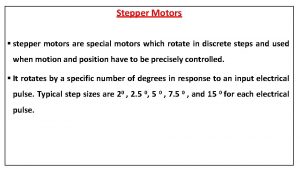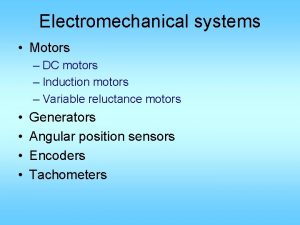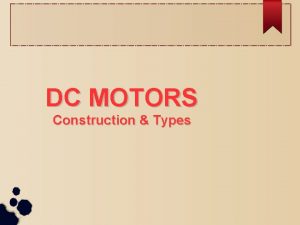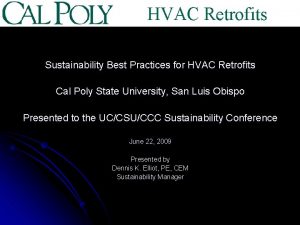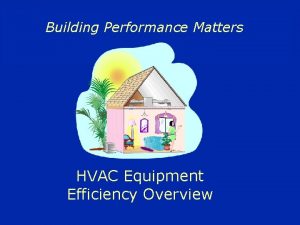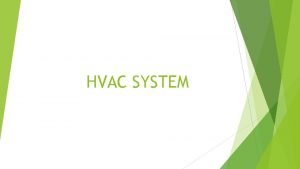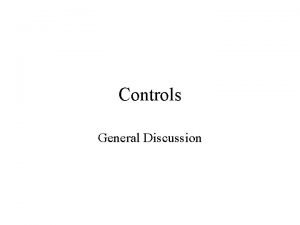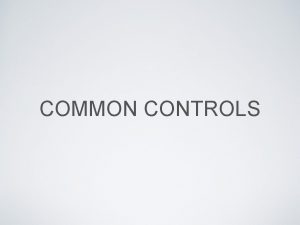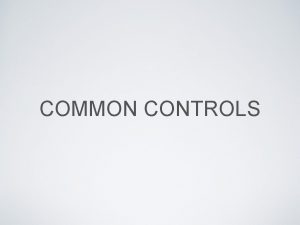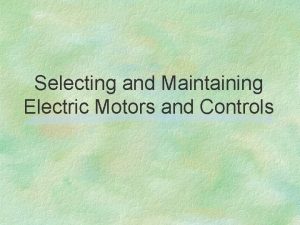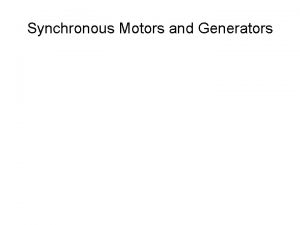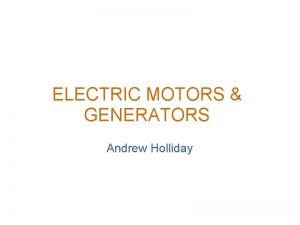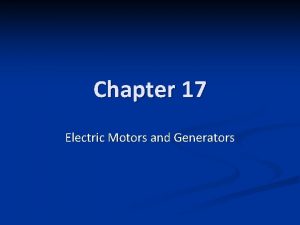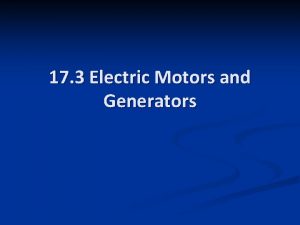HVAC 230 Motors and Controls Unit 17 Types
























































- Slides: 56

HVAC 230 Motors and Controls Unit 17 - Types of Electric Motors 1

17. 1 Uses of Electric Motors • a. Used to turn fans, pumps and compressors • b. Motors are designed for their particular use • c. The correct motor must be used 2

17. 2 a. b. c. d. e. Parts of an Electric Motors Stator (stationary) with windings Rotor (rotates) Bearings End bells Housing 3

17. 3 Electric motors and magnetism • a. Electricity and magnetism are used to create a motor's rotation 1. Unlike poles of magnet attract 2. Like poles of magnet repel • b. Stator has insulated wire windings called running windings, when current is flowing though it will generate a magnetic field 4

17. 3 Electric motors and magnetism • c. Rotor may be constructed of bars 1. Squirrel cage rotor have copper bars 2. Positioned between the run windings • d. Rotor turns within the magnetic field • e. Magnetic field causes the motor to be pulled around the shaft 5

17. 5 Start Winding a. Enables the motor to start b. Ensures that the rotor starts and turns in the proper direction c. Has more turns than the run winding d. Has a higher resistance than the run winding e. Wound with a smaller wire f. Removed from the circuit after the motor starts g. Are slightly out of phase with the run windings 6

17. 6 Starting and Running Characteristics • a. Refrigeration compressor motors must have a high starting torque 1. May need to start with unequal pressures across it 2. Overcome starting resistance • b. Small fans do not require much starting torque 1. Motor must overcome only the friction of the motor itself 2. There is no pressure difference 7

Fig. 17. 8 8

Fig. 17. 9 9

Fig. 17. 7 Electrical Power supplies • a. Residences are furnished with single phase power • b. Many houses can be supplied power from the transformer 10

17. 7 Electrical power supplies • c. Electrical panel – 1. Power enter from the transformer – 2. Power is fed through circuit breakers – 3. Power is distributed throughout the house • d. Typical panel furnishes 120 and 240 volt service • e. Commercial buildings and factories require three phase power 11

Fig. 17. 11 12

Fig. 17. 13 • a. Most operate at 115, 208, or 230 volts • b. Commercial applications can be 208, 230, or 460 volts 13

17. 8 Single phase open motors • c. Some motors can be dual voltage 1. Motor can operate at 115 volts or 230 volts 2. The motor wiring must be changed • d. Some motors can have their direction of rotation changed 14

Fig. 17. 14 15

Fig. 17. 15 16

Fig. 17. 16 17

17. 9 Split-Phase Motors • • • a. Two separate motor windings, start and run b. Good operating efficiency c. Medium amount of starting torque d. Rpm ranges - 1800 to 3600 e. Slip-difference between rated rpm and actual rpm • f. Motor speed is determined by the number of poles • g. To change the rotation of a SPM the tech must change the direction of the current flow through the start windings 18

17. 10 The Centrifugal Switch • a. Commonly used on open motors to disconnect the start winding • b. Disconnects the start winding when the motor reaches about 75% of its rated speed • c. A spark is produced when the switch opens • d. Not used in the refrigerant atmosphere • e. Centrifugal switch is N. C. 19

Fig. 17. 18 20

17. 12 Capacitor-Start Motor • a. Is a split-phase motor • b. Has start and run windings • c. The start capacitor assists the motor by giving it a higher starting torque • d. Start capacitor is wired in series with the start winding of the motor- between R &S • e. Removed from the circuit when the start winding is removed 21

Fig. 17. 19 22

17. 13 Capacitor-Start, Capacitor-Run Motor • a. Same as the split-phase motor • b. Run capacitor is wired to provide efficient running operation • c. Run capacitor is in motor circuit as long as motor is operating • d. The start and run capacitors are wired in parallel with each other • NOTE: Capacitors wired in series with the start windings provide greater starting torque 23

Fig. 17. 21 24

Fig. 17. 22 25

Fig. 17. 23 26

17. 13 Capacitor-Start, Capacitor-Run Motor • f. Motor will draw 10% higher amperage if run capacitor goes bad • g. Most efficient single phase motor used • h. Sometimes used with belt-driven fans 27

17. 14 Permanent Split. Capacitor (PSC) Motor • a. Simplest split-phase motor (fig. 17. 24) • b. Windings same as split-phase motors • c. Run capacitor is connected across the start and run terminals NOTE: PSC motors only has run capacitor • d. Starting torque is low 28

17. 14 Permanent Split. Capacitor (PSC) Motor • e. Good running efficiency • f. Can be multi-speed motor 1. As the resistance of the motor winding decreases, the speed of the motor increases 2. Motor speed changed by switching motor lead wires 3. PSC motor that is running and up to speed will have the start winding energized 29

Fig. 17. 24, 25, 26 30

17. 15 Shaded-Pole Motor • a. Little starting torque • b. Not as efficient as the PSC motor 31

32

Fig. 17. 30 33

17. 16 Three phase motors • • • a. Normally used on commercial equipment b. Must have a three-phase power supply c. Has no start winding or capacitors d. Has three single-phase power supply legs e. The phases can be either two or four poles – 1. 3600 -rpm motors have three sets, each with two poles – 2. 1800 -rpm motors have three sets, each with four poles 34

17. 16 Three phase motors • f. Has high starting torque • g. Actual rotation is about 1750 for 1800 rpm motors • h. Actual rotation is about 3450 for 3600 rpm motors • i. Rotation of motor can be changed by switching any two motor leads 35

Fig. 17. 33 36

17. 17 Single-Phase Hermetic Motors • a. Hermetically sealed from the outside air • b. Similar to single-phase motors (has a start and run winding) • c. Uses relays to remove start winding from motor circuit 37

17. 17 Single-Phase hermetic motors • d. Does not use centrifugal switch • e. Often will have a run capacitor in motor circuit to improve efficiency • f. Designed to operate in a refrigerant atmosphere • g. Refrigerant vapor is used to cool motor 38

17. 17 Single-Phase hermetic motors • h. Motor terminals identified as common, start and run • i Common terminal is connected to both the start and run windings • j. Common terminal to start terminal has the highest resistance • k. Common terminal to run terminal has the lowest resistance 39

17. 18 The Potential Relay • a. Used on motors requiring high starting torque • b. Components 1. Coil • 1. • 2. High resistance (10, 000 to 40, 000 ohms) Wired between terminals 2 and 5 2. Contacts • 1. • 2. Normally closed Connected between terminals 1 and 2 40

17. 18 The Potential Relay • d. The contacts open when the BEMF rises to a specific voltage (pick-up) 1. The start capacitor is removed from the circuit 2. The motor now operates as a PSC motor • e. When the motor turns off, the BEMF drops and the contacts close. NOTE: contacts are normally closed 41

BEMF When a voltage (an electro-motive force) is applied to a motor's windings, current begins to flow, creating a magnetic force which causes the rotor to rotate. A counter force in the form of current is generated by the rotor rotating in the magnetic field. This kick-back is called Back Electromotive Force or Back-EMF (BEMF). The faster the rotor turns, the more BEMF is produced. The current in turn oppose the current flowing in the winding. The net effect is the BEMF limits just how fast the motor or generator can turn. 42

Fig. 17. 38 43

17. 19 The Current Relay • a. Used on single phase, fractional horsepower motors • b. Usually used on fixed orifice type metering devices 1. System pressures can equalize during the off cycle 2. Allows motor to start with less torque 44

17. 19 The Current Relay • c. Components 1. Coil (low resistance, large wire, few turns) 2. Contacts • 1. • 2. Normally open Held open by spring or gravity • d. Upon start-up only the run winding is energized 1. Motor cannot start 2. Draws locked rotor amperage 45

17. 19 The Current Relay • e. Opens and closes its contacts based on the current in the run windings • f. Motor starts with both windings energized • g. After start-up, the amperage drops and the contacts open 46

Fig. 17. 40 47

17. 23 Two-Speed Compressor Motors • a. Used to control the capacity required from small compressors • b. Speed operation is obtained by wiring the compressor motor to operate as a twopole motor or as a four-pole motor • c. Changeover from one speed to the next is obtained from the temperature control thermostat and proper contactor for the proper speed 48

17. 23 Two-Speed Compressor Motors • d. Two-speed compressor motors are considered two motors in one compressor housing • e. One motor turns at 1800 rpm and the other at 3600 rpm • f. Two-speed compressor motors have more than three motor terminals 49

17. 25 Three-Phase Motor Compressors • a. Used in large commercial and industrial installations • b. Normally have three motor terminals • c. No capacitors required • d. Resistance across each winding is the same • Only have run windings 50

17. 25 Three-Phase Motor Compressors e. Three-phase motors have a high starting torque f. Some larger tonnage three-phase motors operate on dual voltages • (Fig. 17. 46) 51

17. 26 Variable Speed Motors • a. Controlling motor speed gives greater efficiency • b. Decreasing motor speed during low load conditions aids in better efficiency • c. The voltage and frequency of the power supply determines motor speed • d. New motors operate at different speeds by the use of electronic controls 52

Electronically commutated motor (fig. 17. 47) Rotor or permanent magnet Choke 53

Electronically commutated motor 54

17. 30 Cooling Electric Motors • a. All motors must be cooled due to the heat given off by the electrical energy used to operate the motor • b. Hermetic motors are cooled by air and refrigerants • c. Hermetic motors cooled by refrigerants must be charged properly 55

17. 30 Cooling Electric Motors • d. Open motors are cooled by air • e. Open motors must be located in areas where there is good air stream • f. Some very large motors are cooled by water 56
 General controls vs application controls
General controls vs application controls He who controls the past controls the future
He who controls the past controls the future Unit 27 commercial ice machines
Unit 27 commercial ice machines Hvac unit 31 test answers
Hvac unit 31 test answers Unit 36 hvac
Unit 36 hvac Hvac unit 41 review questions
Hvac unit 41 review questions Air conditioning basics ppt
Air conditioning basics ppt Unit 18 application of motors
Unit 18 application of motors Difference between pcaob as 1215 and isa 230
Difference between pcaob as 1215 and isa 230 What are the types of hazard controls
What are the types of hazard controls What are the types of hazard controls
What are the types of hazard controls Corrective controls examples
Corrective controls examples Sa 230
Sa 230 Kvalitativa variabler
Kvalitativa variabler 453 en yakın onluğa yuvarlama
453 en yakın onluğa yuvarlama Reglamento de la loei
Reglamento de la loei S-230 crew boss final exam answers
S-230 crew boss final exam answers Projection stéréographique des 32 groupes ponctuels
Projection stéréographique des 32 groupes ponctuels Translatoire
Translatoire Lockheed martin code quest
Lockheed martin code quest 2 cfr part 230
2 cfr part 230 Zodiac cadet aero 270
Zodiac cadet aero 270 Nkb 230
Nkb 230 Msb 230
Msb 230 Duke cs 230
Duke cs 230 Pengertian ukuran sudut
Pengertian ukuran sudut Edu 230
Edu 230 Dermatology case presentation
Dermatology case presentation Compsci 230
Compsci 230 Sci 230
Sci 230 Compsci 230 review
Compsci 230 review Os 230
Os 230 Vodafone infodok 230
Vodafone infodok 230 230 jesse hall columbia mo
230 jesse hall columbia mo Section 230-240 of companies act 2013
Section 230-240 of companies act 2013 Compsci 230 duke
Compsci 230 duke Statistics and correlation
Statistics and correlation Compsci 230
Compsci 230 Unit 6 review questions
Unit 6 review questions Generators and motors
Generators and motors Branchlines gearboxes
Branchlines gearboxes Step motors and control systems
Step motors and control systems Abb motors and generators
Abb motors and generators Dimensional analysis
Dimensional analysis Nascar motors assembles and sells motor vehicles
Nascar motors assembles and sells motor vehicles Service valve hvac
Service valve hvac Hvac system introduction
Hvac system introduction Siemens havc plant applications
Siemens havc plant applications Ansys hvac
Ansys hvac To avoid confusion the gridline system omits the letters
To avoid confusion the gridline system omits the letters Hvac plc controller
Hvac plc controller Hvac industry in india
Hvac industry in india Certification study guide: certified hvac designer (chd)
Certification study guide: certified hvac designer (chd) Shooting range ventilation
Shooting range ventilation Specialty hvac equipment
Specialty hvac equipment York national accounts
York national accounts Seismic wire rope cable bracing factories
Seismic wire rope cable bracing factories
